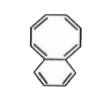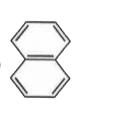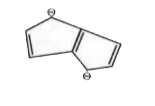Which of the following is a polar moleucule?
The correct Answer is:D
To determine which of the given molecules is polar, we need to analyze each option based on their molecular geometry and dipole moments. Here's a step-by-step solution:
Step 1: Analyze Option A - XeF4
1. Structure: Draw the structure of xenon tetrafluoride (XeF4). It has a square planar geometry due to the presence of two lone pairs on the xenon atom.
2. Electronegativity: Fluorine is more electronegative than xenon, creating dipole moments pointing towards each fluorine atom.
3. Dipole Moment: The dipole moments from the four fluorine atoms cancel each other out due to symmetry. Therefore, the net dipole moment is zero.
4. Conclusion: XeF4 is a non-polar molecule.
Step 2: Analyze Option B - BF3
1. Structure: Draw the structure of boron trifluoride (BF3). It has a trigonal planar geometry.
2. Electronegativity: The fluorine atoms are more electronegative than boron, creating dipole moments pointing towards each fluorine atom.
3. Dipole Moment: The dipole moments from the three fluorine atoms also cancel each other out due to symmetry. Thus, the net dipole moment is zero.
4. Conclusion: BF3 is a non-polar molecule.
Step 3: Analyze Option C - C2F4
1. Structure: Draw the structure of difluoroethylene (C2F4). It has a planar structure with a double bond between the two carbon atoms.
2. Electronegativity: The fluorine atoms are more electronegative than carbon, creating dipole moments towards each fluorine atom.
3. Dipole Moment: The dipole moments from the two fluorine atoms on one carbon cancel with the dipole moments from the two fluorine atoms on the other carbon due to symmetry. Therefore, the net dipole moment is zero.
4. Conclusion: C2F4 is a non-polar molecule.
Step 4: Analyze Option D - PCl2F3
1. Structure: Draw the structure of phosphorus dichloride trifluoride (PCl2F3). It has a trigonal bipyramidal geometry.
2. Electronegativity: Fluorine is more electronegative than chlorine, creating dipole moments towards each fluorine atom.
3. Dipole Moment: The dipole moments from the two chlorine atoms and three fluorine atoms do not cancel out due to the different electronegativities and the arrangement of atoms. Therefore, the net dipole moment is not zero.
4. Conclusion: PCl2F3 is a polar molecule.
Final Answer
The polar molecule among the given options is Option D: PCl2F3.
---
1. Structure: Draw the structure of xenon tetrafluoride (XeF4). It has a square planar geometry due to the presence of two lone pairs on the xenon atom.
2. Electronegativity: Fluorine is more electronegative than xenon, creating dipole moments pointing towards each fluorine atom.
3. Dipole Moment: The dipole moments from the four fluorine atoms cancel each other out due to symmetry. Therefore, the net dipole moment is zero.
4. Conclusion: XeF4 is a non-polar molecule.
1. Structure: Draw the structure of boron trifluoride (BF3). It has a trigonal planar geometry.
2. Electronegativity: The fluorine atoms are more electronegative than boron, creating dipole moments pointing towards each fluorine atom.
3. Dipole Moment: The dipole moments from the three fluorine atoms also cancel each other out due to symmetry. Thus, the net dipole moment is zero.
4. Conclusion: BF3 is a non-polar molecule.
1. Structure: Draw the structure of difluoroethylene (C2F4). It has a planar structure with a double bond between the two carbon atoms.
2. Electronegativity: The fluorine atoms are more electronegative than carbon, creating dipole moments towards each fluorine atom.
3. Dipole Moment: The dipole moments from the two fluorine atoms on one carbon cancel with the dipole moments from the two fluorine atoms on the other carbon due to symmetry. Therefore, the net dipole moment is zero.
4. Conclusion: C2F4 is a non-polar molecule.
1. Structure: Draw the structure of phosphorus dichloride trifluoride (PCl2F3). It has a trigonal bipyramidal geometry.
2. Electronegativity: Fluorine is more electronegative than chlorine, creating dipole moments towards each fluorine atom.
3. Dipole Moment: The dipole moments from the two chlorine atoms and three fluorine atoms do not cancel out due to the different electronegativities and the arrangement of atoms. Therefore, the net dipole moment is not zero.
4. Conclusion: PCl2F3 is a polar molecule.
The polar molecule among the given options is Option D: PCl2F3.
Similar Questions
Knowledge Check
Which of the following is most polar?
A B
B C
C D
D
Which of the following is non polar species.
ASO2BCO2CH2ODNH3Which of the following is polar aprotic solvent ?
ADMSOBCrown ether:CDMGDAll of these
Which of the following is a polar molecule
View SolutionWhich of the following is polar ? .
View SolutionWhich of the following is non-polar molecular solid?
View SolutionWhich of the following is a non-polar amino acid?
(a) Alanine
(b) Glutamic acid
(c) Serine
(d) none of these
View SolutionWhich of the following is most polar bond ?
View Solution
